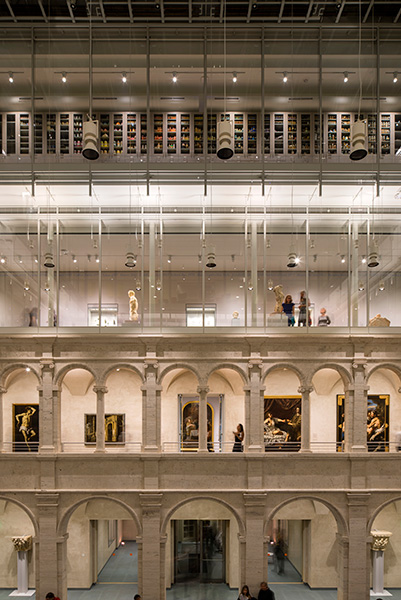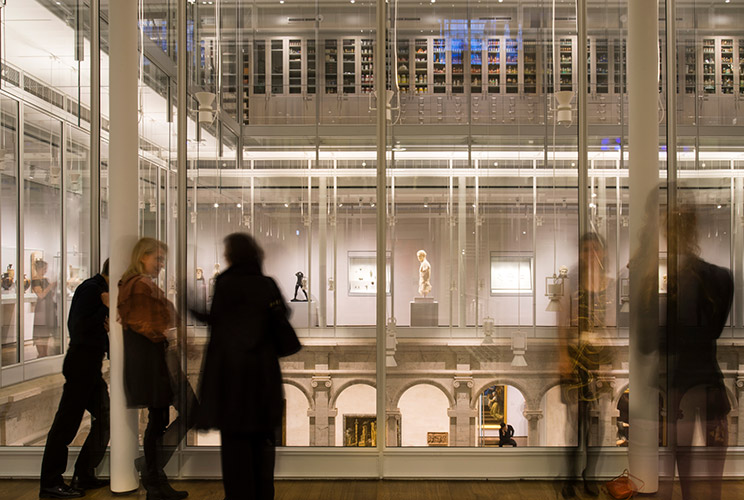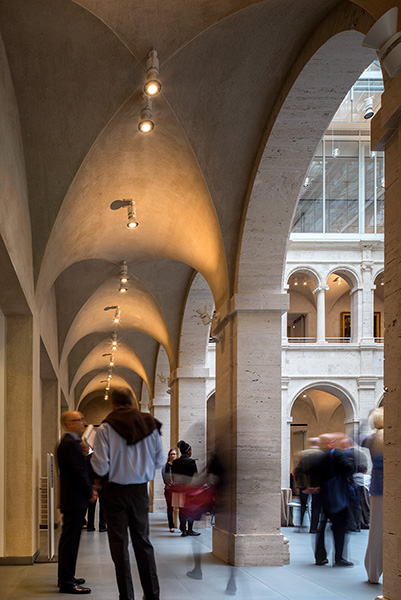Ever since the 1927 opening of the historic Fogg Museum, the Calderwood Courtyard has been a central artery of the Harvard Art Museums. It’s where visitors orient themselves and where journeys into our collections and programs begin. It’s where students and professors meet before heading into the galleries and where friends catch up over lattes or lunch at Jenny’s Cafe. It’s where visitors or those just stopping by can browse through books inside our shop. It’s where student-led gallery tours kick off and one-of-a-kind musical and performance art events are staged. After hours, it’s where dazzling private weddings, galas, and conferences unfold.
With its role as host and backdrop to so many social activities at the museums, the courtyard hews to the model of an Italian piazza, a center for gathering and socializing in ways both formal and informal. And that’s exactly what architect Renzo Piano envisioned for the space when he led the building’s massive renovation and expansion project, completed in 2014. “I hope people will rendezvous in the piazza,” Piano said at the time.
The courtyard’s distinctly Italian character is, in fact, embedded within its DNA. Designed by architects Coolidge, Shepley, Bulfinch and Abbott, the courtyard’s arches were modeled after the facade of the 16th-century canon’s house of the San Biagio complex in Montepulciano, Italy. (The complex, which includes a church and cistern, was designed by architect Antonio da San Gallo the Elder.) Using the same travertine stone as in the original canon’s house, the architects reproduced the Renaissance arches four times and turned them inward—an effect that suggests a variety of entrances through which the museums can be explored.
Thanks to the Renzo Piano Building Workshop’s innovative renovation, the courtyard has become even more dynamic. The building’s new glass roof (which Piano called the “light machine”) enables controlled natural light to filter down through all five of the museums’ public floors, brightening the courtyard and making more visible its inhabitants and activities. Also capturing new attention now are the Pennsylvania bluestone tiles covering the courtyard’s floor. Though this type of flooring was part of the original courtyard, new tiles of the fine-grain stone were laid in order to seamlessly align with the travertine columns.
A spectacular work in itself, the Calderwood Courtyard is surrounded by objects from the museums’ collections. Visitors have the opportunity to appreciate a variety of art—from the eight medieval stone capitals (fixtures of the old courtyard), to the iconic Chinese and German sculptures from the collections of the Arthur M. Sackler Museum and Busch-Reisinger Museum, to the commissioned steel mobile by contemporary Mexican artist Carlos Amorales.
The works’ purposeful placement—around a space that is open to the public and does not require an admission fee—is part of the museums’ Art in Public Spaces initiative, which seeks to connect more people with original works of art. It’s a sentiment that likely would have pleased the courtyard’s namesake, Norma Jean Calderwood. An intrepid student and collector of Islamic art, Calderwood and her husband, Stanford Calderwood, were generous local benefactors of the arts.
The Calderwood Courtyard is available for private event rentals, providing a sophisticated atmosphere for weddings, parties, and corporate events. See our rentals page for more information.






